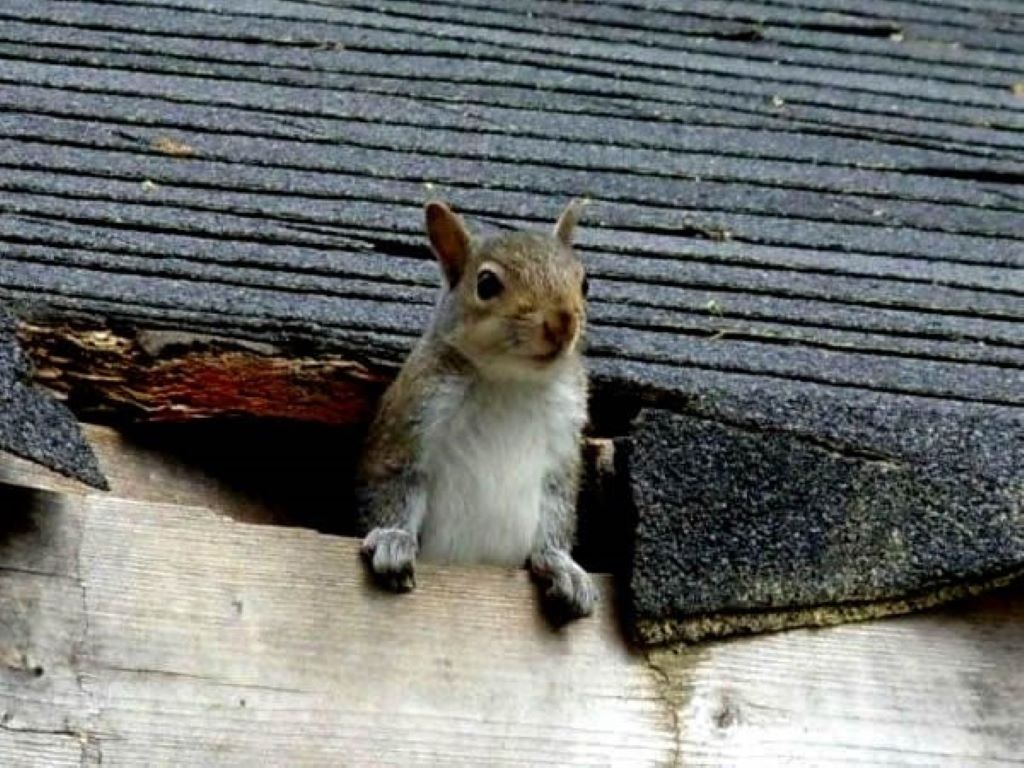
04 Feb How to Get Squirrels Out of Attic? A Comprehensive Guide
To get squirrels out of the attic, seal all entry points and use humane traps to catch and remove them. Having squirrels in your attic can be a nuisance and cause damage to your property. Squirrels can enter your attic through small openings and once they are inside, they can build nests, chew on wires, and cause other forms of destruction. If you are facing this problem, it is important to take immediate action to remove them.
This guide will provide you with effective methods to get squirrels out of your attic for good. By following these steps, you can ensure a squirrel-free and damage-free attic space.
Identifying The Problem

When squirrels invade your attic, it can quickly escalate into a nuisance. Not only do they make irritating noises, but they can also cause severe damage to your property. Prompt identification of the problem is essential for taking appropriate action. In this section, we will examine the signs of a squirrel infestation and how to assess the extent of the issue. Detecting early indicators, such as scratching sounds, droppings, or damage to insulation and wiring, is crucial. For more in-depth information on dealing with squirrel infestations and preventing future occurrences, Themadething.com offers valuable resources and expert advice to help you effectively manage these unwelcome attic visitors.
Signs Of Squirrel Infestation
If you suspect squirrels have taken up residence in your attic, there are several telltale signs to look out for:
- Scratching and scurrying sounds: Squirrels are active animals, and you may hear them moving around in your attic. These sounds are often loud early in the morning or late in the evening.
- Droppings and urine stains: Squirrels leave behind droppings that resemble small, dark pellets. Additionally, you might notice urine stains on the attic floor or around entry points.
- Chewed wires and insulation: Squirrels have a natural tendency to gnaw on objects, including electrical wiring and insulation. Look for chewed wires or insulation damage as a sign of their presence.
- Visible entry points: Take a thorough look around your attic for any holes or openings squirrels may have used to gain access. These entry points are often found near rooflines, vents, or eaves.
Assessing The Extent Of The Issue
After identifying signs of squirrel infestation, it is crucial to assess the extent of the issue to determine the appropriate measures to take. Here are some steps you can follow:
- Observe squirrel activity: Spend time monitoring the squirrels’ behavior to understand their patterns and establish the population size. This will assist in planning the most effective removal strategy.
- Inspect the attic: Carefully inspect the attic for any damage caused by the squirrels. Check for chewed wires, chew marks on wood panels and nesting materials. This will provide insight into the length of their stay and the level of damage they have caused.
- Look for food sources: Squirrels often find food sources near your property, such as bird feeders or uncovered garbage cans. Identifying these sources can help prevent future infestations once the current issue is resolved.
- Consult a professional: If you are unsure about the severity of the squirrel infestation or the best course of action, consider contacting a professional pest control company. They have the knowledge and experience to assess the situation accurately and suggest tailored solutions.
By recognizing the signs of squirrel infestation and thoroughly assessing the extent of the issue, you will be better equipped to handle the situation effectively. In the next section, we will discuss the various methods for safely and humanely removing squirrels from your attic.
Creating A Removal Plan
When it comes to dealing with squirrels in your attic, creating a removal plan is essential for a successful outcome. Understanding squirrel behavior and choosing the right removal method are two key factors that will help you effectively get squirrels out of your attic.
Understanding Squirrel Behavior
Before attempting to remove squirrels from your attic, it’s important to have a good understanding of their behavior. Squirrels are agile and persistent creatures that are attracted to attics because of their warmth and shelter. One question that might come up when dealing with squirrels is do squirrels eat bread? While bread is not a natural part of a squirrel’s diet, they might consume it if it’s readily available. However, it’s not a significant factor in attracting them to attics. More importantly, squirrels can cause extensive damage to insulation, electrical wiring, and other structural components of your home. By understanding their behavior, you’ll be better equipped to devise an effective removal plan that addresses the specific challenges they present.
Squirrels are most active during the early morning and late afternoon hours. They are excellent climbers and can gain access to your attic through small openings and gaps. They are known for chewing through materials to create entry points. Knowing their patterns and entry points will help you locate and seal off any potential access areas.
Choosing The Right Removal Method
When it comes to removing squirrels from your attic, there are several methods to choose from. The best method will depend on the severity of the infestation and your personal preference. Here are some popular removal methods:
- Live Traps: Live traps are humane and allow you to capture squirrels without harming them. Place the traps near their entry points and bait them with squirrel food or nuts. Once trapped, release the squirrels far away from your home.
- One-Way Doors: One-way doors are designed to allow squirrels to exit your attic but prevent them from re-entering. Install these doors in the areas where squirrels are gaining access, and they will leave on their own but won’t be able to return.
- Exclusion: Exclusion involves sealing off all potential entry points to prevent squirrels from entering your attic. This method requires a thorough inspection of your home and the use of materials such as wire mesh, caulk, or steel wool to close off any openings. It’s important to make sure all entry points are secured to avoid future infestations.
Before implementing any removal method, check local regulations and consult with professionals if needed. It’s important to handle squirrel removal safely and effectively to protect both you and the squirrels.
Preparing For Removal
Gathering Necessary Tools And Equipment
Before beginning the squirrel removal process, gather the following tools and equipment:
- Flashlight
- Gloves
- Protective eyewear
- Ladder
- Traps or cages
- Sealant or caulk
- Duct tape
Safety Precautions
It’s essential to prioritize safety when removing squirrels from the attic. Consider the following safety precautions:
- Wear protective clothing, including gloves and eyewear, to minimize contact with potential hazards.
- Use a sturdy ladder with proper stability to access the attic space safely.
- Avoid direct contact with squirrels to reduce the risk of bites or scratches, and potential exposure to diseases.
- Ensure proper ventilation in the attic to minimize the risk of inhaling potentially harmful particles or odors.
- Secure any potential entry points to prevent squirrels from re-entering the attic.
Executing The Removal
Once you have devised a plan to get squirrels out of your attic, it’s time to put that plan into action. Executing the removal requires careful implementation and the ability to handle any unexpected challenges that may arise. With the right approach, you can effectively and humanely remove squirrels from your attic, restoring peace and tranquility to your home.
Implementing The Removal Plan
To successfully implement your removal plan, it is crucial to take proactive steps that will effectively deter squirrels from your attic. Here are some key strategies to consider:
- Sealing Entry Points: Identify and seal any openings or potential entry points that squirrels may be using to access your attic. Use sturdy materials such as steel mesh or metal flashing to ensure they cannot chew through.
- Using Repellents: Scent-based repellents can be effective in discouraging squirrels from entering your attic. Look for products that are specifically formulated for squirrels and follow the instructions for application.
- Removing Attractive Features: Squirrels are attracted to food sources and cozy nesting spots. Make sure any potential food sources, such as bird feeders or garbage cans, are secured and inaccessible to squirrels. Additionally, remove any nesting materials or debris that may entice them to stay.
Dealing With Unexpected Challenges
While executing the removal plan, it is important to be prepared for unexpected challenges that may arise. Here are some potential obstacles you may encounter and ways to overcome them:
| Challenge | Solution |
| Nesting Young | If you discover baby squirrels in your attic, proceed with caution. Avoid separating them from their mother, as it may lead to abandonment. Instead, wait for the young squirrels to mature and leave the nest before sealing entry points. |
| Persistent Squirrels | If squirrels continue to find their way back into your attic despite your efforts, consider consulting with a professional wildlife removal service. These experts have the knowledge and tools to tackle the situation effectively and ensure a long-term solution. |
| Health and Safety Risks | When handling squirrels or cleaning up their nesting materials, it is important to prioritize your health and safety. Wear protective gloves and a mask to prevent the spread of diseases and avoid direct contact with the animals. |
By anticipating and addressing these unexpected challenges, you can stay on track with the removal process and achieve a squirrel-free attic. Remember, patience and persistence are key when it comes to successful squirrel removal.
Preventing Future Infestations

Once you have successfully removed squirrels from your attic, taking steps to prevent future infestations is crucial. By sealing entry points and maintaining a squirrel-free attic, you can ensure that these furry intruders won’t make their way back into your home. Let’s explore these measures in detail:
Sealing Entry Points
To keep squirrels out of your attic, it is essential to identify and seal all the possible points of entry. Squirrels can fit through even small openings, so a thorough inspection is necessary. Here are some steps you can take:
- Examine your roof: Look for any loose or damaged shingles, as well as gaps in the eaves and vents.
- Inspect the exterior walls: Check for cracks, holes, or gaps around utility lines, pipes, and windows.
- Seal openings: Use materials like steel wool, mesh, or caulk to fill in any gaps or holes you discover. Pay particular attention to areas where electrical wires enter your home.
- Cover chimneys and vents: Install chimney caps and mesh coverings over vents to prevent squirrels from gaining access.
Maintaining A Squirrel-free Attic
Once you have sealed all potential entry points, your focus should shift towards maintaining a squirrel-free attic. Here are some steps you can take to ensure these critters stay away:
- Trim nearby trees: Squirrels can use overhanging branches as launchpads to leap onto your roof. By trimming back tree branches, you can make it more difficult for them to access your attic.
- Secure garbage bins: Squirrels are attracted to food sources, so be sure to keep your garbage bins securely closed to discourage them from coming near your home.
- Remove potential nesting materials: Clear your attic of any potential nesting materials such as leaves, twigs, or piles of debris that squirrels might find appealing.
- Maintain regular inspections: Regularly inspect your attic for signs of squirrel activity, such as chewed wires or gnawed wooden beams. Early detection can help prevent infestation.
By following these steps to prevent future infestations, you can safeguard your attic from the unwanted presence of squirrels. Remember, taking proactive measures is essential to keep these persistent critters at bay and ensure a squirrel-free home.
Frequently Asked Questions For How To Get Squirrels Out Of Attic
How Do Squirrels Get In The Attic?
Squirrels can access the attic through small openings like gaps in the roof, and vents, or even chew through weak areas. It’s important to identify these entry points to effectively block their access and prevent further infestation.
What Damage Can Squirrels Cause In The Attic?
Squirrels can cause extensive damage in the attic by gnawing on wood, insulation, and electrical wiring. This can lead to structural damage, fire hazards, and energy loss. Taking immediate action to remove squirrels from the attic can help reduce these risks.
What Are The Signs Of Squirrels In The Attic?
Signs of squirrels in the attic include scratching noises, droppings, chewed wires or insulation, and visible entry points. It’s essential to address these signs promptly to prevent further damage and ensure the safety of your home.
Conclusion
Removing squirrels from your attic requires patience and a strategic approach. Embrace the beauty of your outdoor space with our eight decoration tips for gardens, and by following the steps outlined in this guide, you can also safely and effectively evict furry intruders from your home. Remember to seal any entry points to prevent future infestations, ensuring your garden remains a tranquil retreat for you to enjoy.
With these tips, you can reclaim your attic and restore peace to your home.

Sorry, the comment form is closed at this time.